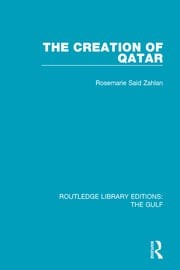The classic history of Qatar was written by Rosemarie Said Zahlan in 1979, titled The Creation of Qatar. The author is the sister of Edward Said (yes, the Edward Said), and she also wrote a history of the UAE (in 1978) and the region (in 1998). Zahlan's book is a reference / source book for almost all other histories of the country. Given its date of publication, its strength is offering more detailed perspectives of a different era, as history was viewed in the post-independence period and providing details of that time period itself. Somewhat surprisingly, given its centrality, the book is lightly cited in many chapters, leaving authors having to guess where all the detailed historical recounting is sourced from. As an example, for Chapter 2 on the period of 1766-1820 there are only 11 footnotes, several of which are explanatory notes and do not contain references to sources. What footnotes we have suggest that the sources are primarily from the British colonial record, and some other English sources, such as from Aramco, along with a few Arabic sources.
The focus of this history is from 1766 onward, with chapters respectively covering the eras of 1766-1820, 1820-1913, 1872-1916, post-1916, 1935 and oil, there is also a chapter on territorial disputes and chapters on socio-cultural topics. All of the chapters are quite brief (the entire book is 160 pages). For historical books on Qatar that followed it, Zahlan's work is focal, and continues to be a key reference point (however the book written by Crystal in 1990 is the most cited). This history, like that of Al-Shelek et al, places more emphasis on Qatar's internal history, than an (over)emphasis on the external as well as colonial actions and roles. The social chapters are probably the most valuable contributions, such as Zahlan's demographic data showing that the foreign population of Qatar was 39% in 1939 and 59% in 1971 as well as the 1970 Qatari population at 45,000 (well cited tables list all the available sources on population; this a unique source on an issue about which there is limited data). There is a detailed table on education (students, teachers, school), which is another great source for documents that are currently difficult to find.
Zahlan has a concluding chapter on the future of Qatar. While it is not predictive, the author suggests that hydrocarbons will remain focal to the economy up to 2000 and beyond, giving the nation and its people the potential for prosperity. Zahlan notes investment in education as well as giving girls and women opportunities (in education and work) as key pathways for economic and social development. The author also highlights that the necessity of positive regional partnership will continue given that she predicts that the country will not not be able to be self sufficient in many regards. One of the challenges Zahlan raised in 1979 was being able to fuse innovation and technology with national heritage, which remains an on-going one.

